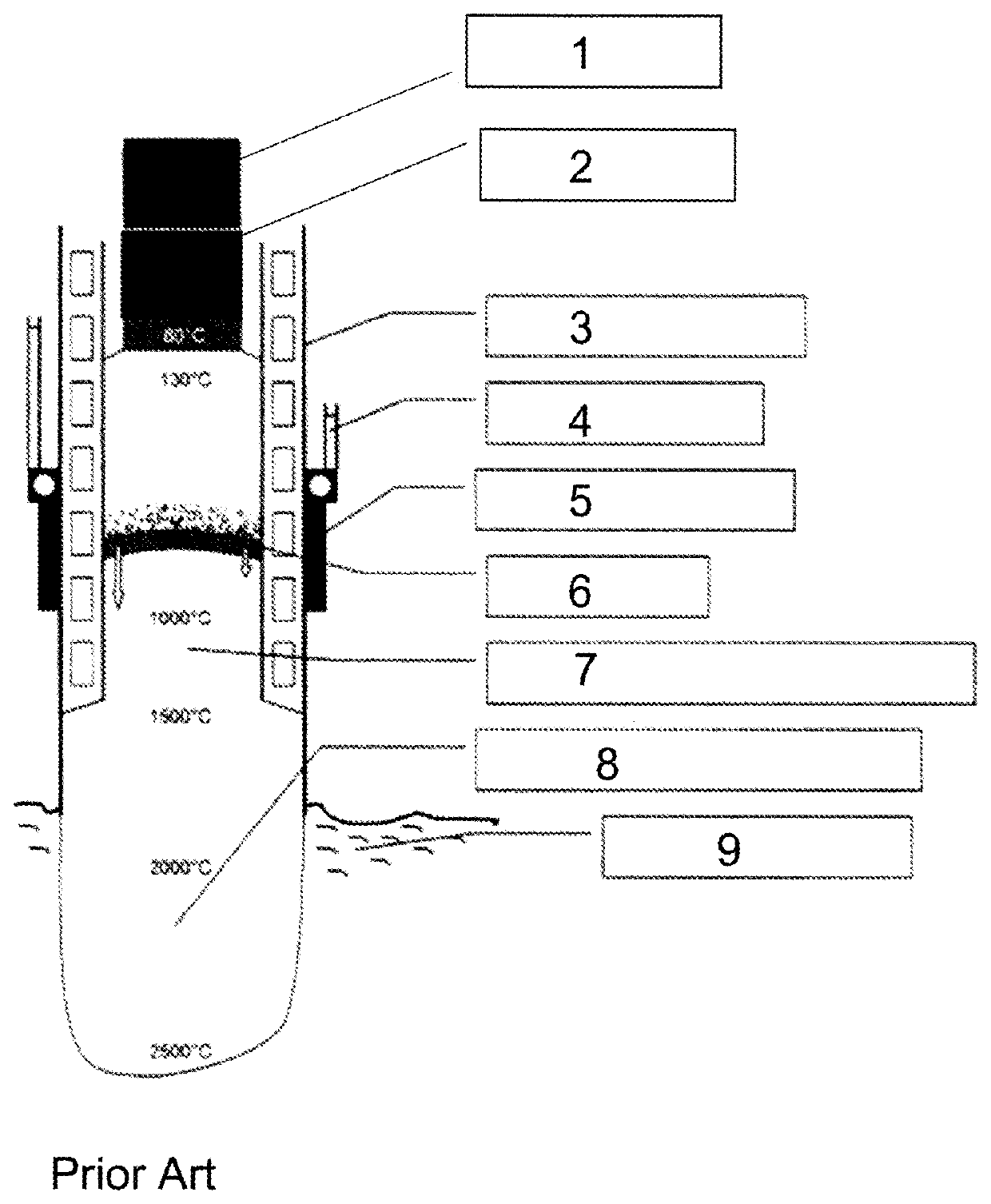Electrode composition
a composition and electrode technology, applied in the direction of electrodes, electric discharge heating, electrical apparatus, etc., can solve the problems of falling off the electricity bars, mechanical instability of the anode, and failure to use non-toxic binders
- Summary
- Abstract
- Description
- Claims
- Application Information
AI Technical Summary
Benefits of technology
Problems solved by technology
Method used
Image
Examples
example 1
E COMPOSITION ANTHRACITE (GAS-CALCINED)”
[0057]A first example for a self-calcining electrode composition for electric arc furnaces has the following components: 22% of bitumen as binder; 28% of coke in the form of coke dust with a grain size fraction of 0<x≤0.21 mm; 2% of graphite in the form of graphite dust. Coke dust and graphite dust have a specific surface according to Blaine of 4500-6000 Blaine; 11% of a mixture of gas-calcined anthracite with coke in the mixing ratio of gas-calcined anthracite:coke=3:1 with a fine grain fraction of 0<x≤0.84 mm; 15% of a mixture of gas-calcined anthracite with coke in the mixing ratio of gas-calcined anthracite:coke=3:1 with an average grain fraction of 0.84-3.36 mm; 17% of a mixture of gas-calcined anthracite with coke in the mixing ratio of gas-calcined anthracite:coke=3:1 with a coarse grain fraction of 3.36-20 mm and 5% of graphite with a grain fraction between 1 and 25 mm.
[0058]In response to the production of the self-calcining electrode...
example 2
E COMPOSITION COKE”
[0060]A second example for a self-calcining electrode composition for electric arc furnaces has the following components: 24% of bitumen as binder; 28% of coke in the form of coke dust with a grain size fraction of 0<x≤0.21 mm; 3% of graphite in the form of graphite dust. Coke dust and graphite dust have a specific surface according to Blaine of 4500-6000 Blaine; 8% of coke with a fine grain fraction of 0<x≤0.84 mm; 17% of coke with an average grain fraction of 0.84-3.36 mm; 15% of gas-calcined anthracite with a coarse grain fraction of 3.36-20 mm and 5% of graphite with a grain fraction between 1-25 mm.
[0061]The above-listed components are mixed at a mixing temperature of 175° C.
[0062]In response to the production of the self-calcining electrode composition, the above-mentioned components as well as optionally further additives are broken, ground and classified. The obtained dry mixture is subsequently preheated to 120 to 200° C., preferably to 160-180° C., parti...
example 3
COMPOSITION ECA (ELECTRICALLY CALCINED ANTHRACITE)
[0064]A third example of a self-calcining electrode composition for electric arc furnaces has the following components: 26% of bitumen as binder; 35% of electrically calcined anthracite in the form of anthracite dust with a grain size fraction of 0<x≤0.21 mm and a specific surface according to Blaine of 4500-6000 Blaine; 5% of electrically calcined anthracite with a fine grain fraction of 0<x≤0.84 mm; 5% of electrically calcined anthracite with an average grain fraction of 0.84-3.36 mm, and 29% of electrically calcined anthracite with a coarse grain fraction of 3.36-20 mm.
[0065]Comparison of typical characteristic values of an electrode composition with coal tar pitch as binder and a bituminous electrode composition after the calcination at 1000° C. (laboratory test) according to the preceding second example:
[0066]
ElectrodeElectrodecompositioncompositionProperties(bitumen)(pitch)UnitStandardCalcined1.401.49g / cm3ISO 12985-1densityElec...
PUM
| Property | Measurement | Unit |
|---|---|---|
| density | aaaaa | aaaaa |
| softening point | aaaaa | aaaaa |
| softening point | aaaaa | aaaaa |
Abstract
Description
Claims
Application Information
 Login to View More
Login to View More - R&D
- Intellectual Property
- Life Sciences
- Materials
- Tech Scout
- Unparalleled Data Quality
- Higher Quality Content
- 60% Fewer Hallucinations
Browse by: Latest US Patents, China's latest patents, Technical Efficacy Thesaurus, Application Domain, Technology Topic, Popular Technical Reports.
© 2025 PatSnap. All rights reserved.Legal|Privacy policy|Modern Slavery Act Transparency Statement|Sitemap|About US| Contact US: help@patsnap.com

